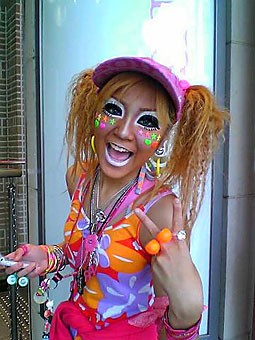While the samurai in the painting looks like a typical traditional Japanese woodblock, he’s holding a modern handgun instead of a sword. He’s also smoking a cigarette that twists inside his mouth, and his battle gear is replaced with loads of shiny bling necklaces and jewelry, long cornrows and a jacket with a black fur collar.
“”Blackface No. 43″” by Iona Rozeal Brown is a hip-hop samurai and fits nicely with the seven other depictions of Japanese icons updated to illustrate black street culture, all on display at the UA Museum of Art.
In union with the traveling exhibit “”The Faithful Samurai,”” an assortment of 1800s woodblock prints, Brown’s works explore the international influence of hip-hop today. While the larger exhibit is inspired by the execution of 47 samurai after they took revenge on a lord for killing their master, Brown’s paintings take root from the modern fashion trend of ganguro.
On a trip to Tokyo in 2001, Brown saw a scourge of young Japanese girls emulating American pop culture by dressing like Paris Hilton, profusely tanning their skin and dyeing their hair blonde. The goal of the movement is to look as American as possible, washing away any ties to their native country and home.
This idea is omnipresent in each of her paintings, which show how American culture can affect every area of the world. When you look closely at each selection, you can see their dark faces are painted on, with paler skin poking out from underneath on the edges of their heads.
No. 80 is grabbing his crotch and holding a glitzy bottle of wine in the other hand while ostentatiously smoking a cigar. No. 54 has a gigantic black afro with a hair comb nestled inside, while No. 47 is twisting his fingers into a peace sign.
All of these men reflect the changing world culture of globalization and America’s higher prominence in the world. They are a comment on what it means for different cultures to take on the looks of others.
It’s important to note that the ganguro fashion trend does not have any history behind it and is based entirely on fashion and appearance. The followers do not have distinct thematic reasons for dressing American, other than what is presented in the media today.
In that context, it’s reasonable to say that Brown’s acrylics are a critique on popular culture, and force us to evaluate the negative effects of the media and advertising on heritage and traditions.
Because these serve as a bridge between classic male woodblocks and today’s art scene, they are focused solely on men. While this serves as an illustrative comparison, it leaves the exhibit wanting. Many of Brown’s most famous portraits are of women, and since the ganguro are solely composed of the fairer sex, one gets a sense of missing out on something.
But as they are, the men serve as a postmodern pastiche of classical Eastern painting and also help give a new perspective on both traditions. With relatable hip-hop images, the paintings reach out to those more fascinated with Jay-Z than J-pan.
The exhibition will be going on through Jan. 7, and artist Iona Rozeal Brown will lecture at the Center for Creative Photography on Nov. 16 at 5:30 p.m. The event is free and open to the public.









